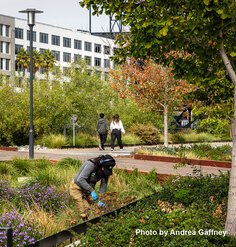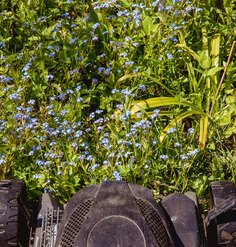Meadow Creek: Monitoring for Long-Term Performance
By Margaret Graham, MLA Candidate and Leena Cho, Lecturer in Landscape Architecture, School of Architecture, University of Virginia
The three projects that our Case Study Investigation (CSI) team researched this summer — Monticello’s Visitor Center (Michael Vergason Landscape Architects), JMU’s College of Integrated Science and Technology landscape (Rhodeside & Harwell), and the Meadow Creek restoration (The Nature Conservancy & VHB) — promote environmental stewardship via careful and innovative integration of best management practices (BMPs) and native plant palettes into the project site.
One aspect that interested us most was the post-design maintenance strategies for each project. The Monticello and JMU projects are operated and maintained by well-defined institutions: Thomas Jefferson Foundation and James Madison University, respectively. They have internal grounds and maintenance departments and staff with protocols for plant management, such as hours per season for pruning, and frequency and style of irrigation. We consider this to be typical for many landscape architecture projects, and because the procedures for maintenance at these institutions is so predicated, we were able to quantify the economic benefit of different planting styles in terms of the maintenance resources that they require.
The Meadow Creek restoration differed in that it is on public land and has no dedicated maintenance staff. We were interested in the long-term maintenance of this site that is occurring through a 10-year monitoring project conducted by The Nature Conservancy (TNC) and Vanasse Hangen Brustlin, Inc (VHB) environmental engineers. The monitoring is a stipulation of the support from the project funder: The Virginia Aquatic Resources Trust Fund. The Fund supports large-scale conservation efforts and specifies the ecological success of these efforts. Therefore, the Fund requires on-going monitoring of the Meadow Creek restoration.
TNC set aside 20% of the construction budget from the beginning of the project to fund maintenance and monitoring efforts. According to TNC’s website, the scope of the monitoring “include[s] assessment of native vegetation, invasive species, stream stability, aquatic habitat features, and wetland function.” Since the project’s completion in 2013, TNC and VHB have collaborated on reporting each of these assessments. Four TNC staff and two volunteers, with backgrounds in biology, ecology and environmental science, collect data over 12 days each year during the growing season. The team collects water quality parameters with probes and measures vegetation using measuring tapes and cameras. VHB’s monitoring team includes two field staff using survey equipment to conduct stream channel geomorphology monitoring.
TNC’s unique role as project coordinator allows them to actively respond to the findings of the ongoing monitoring to help ensure the growth and health of the riparian ecosystem. According to Diane Frisbee of the Nature Conservancy, 2,500 new trees and shrubs were planted this spring, one year after the completion of the initial installation, as a response to the observations of their year one monitoring report. TNC also sponsors invasive removal events to help maintain the goal of <5% invasive cover. The first year monitoring report resulted in repair of root wads and other structural features as well as additional planting of live stakes that help stabilize the stream bank.
This 10-year monitoring effort increases the long-term environmental benefits of the project by assuring the success of each landscape feature and the health of the overall ecosystem. By requiring ecological goals as a guiding principle of the project, the 10 years of close monitoring will likely sustain its success for decades.
Research Fellow Leena Cho and student Research Assistant Margaret Graham are participating in LAF’s 2014 Case Study Investigation (CSI) program. They are working to evaluate and document the performance of three exemplary landscape projects in Central Virginia.











